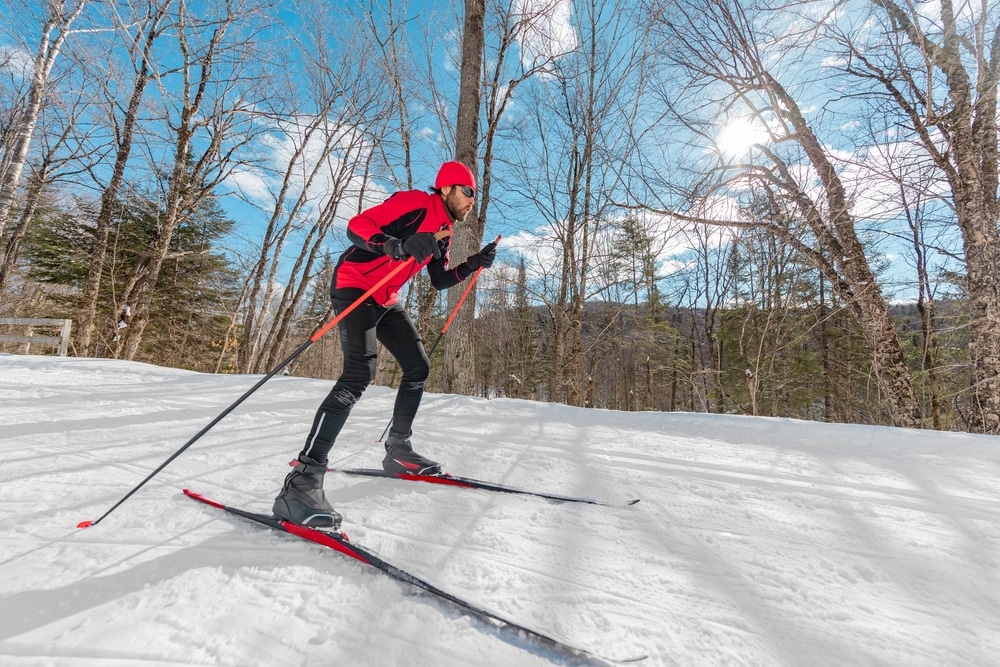Table of Contents
Skate on skis is one of the most popular winter sports, like bike skiing and surf skiing. However, to enjoy the snowy winter adventures of ice skating, it is essential to blend the techniques of skiing and skating by choosing the perfect equipment and mastering the techniques to conquer them. This article will cover a detailed guide on the type of skis to use, proper techniques, and essential tips to help you master this winter sport. You will master the art of skiing by following these tips and techniques.
What is Skate Skiing?
Skate skiing or skate on skis is a type of cross-country skiing in which the skier moves like ice skating. Unlike traditional cross-country skiing, it uses a diagonal stride on groomed routes, which travels along parallel lines. The skis used are shorter and stiffer, and the poles are longer than those used in classic skiing.
1. Choosing the Right Equipment
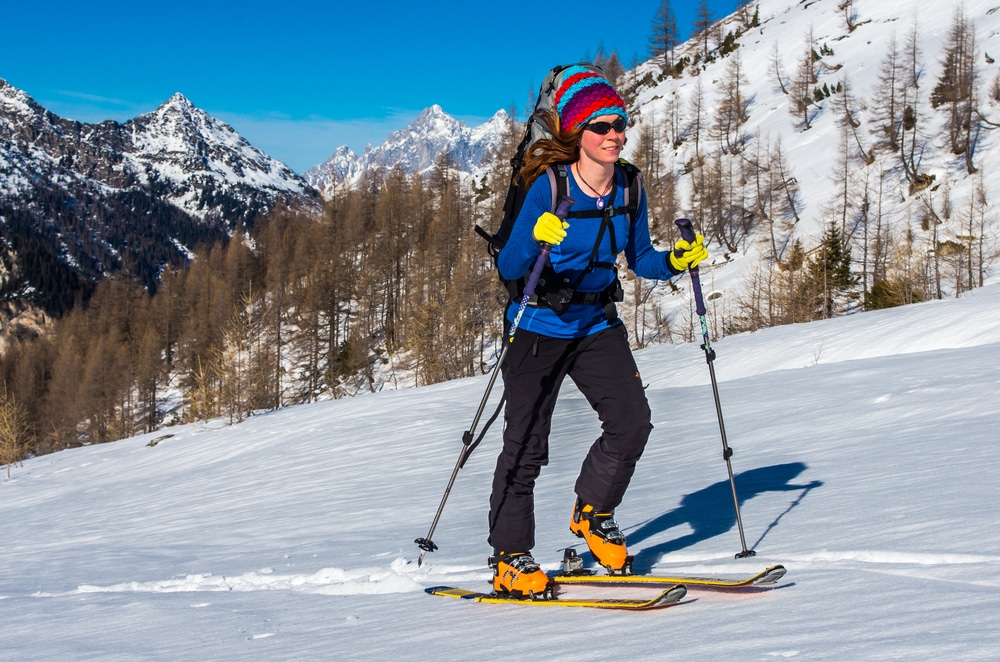
Skis
It’s important to recognize the differences between skate skis and classic cross-country skis while choosing skates. Skate skis are made for lateral mobility and are shorter, stiffer, and more rigid. The stiff flexes in the skis are essential for transferring power from your legs to the snow, enabling a more efficient leg push. Skate skis normally come in a length of 170-192 cm, depending on the weight and height of the skier. It’s essential to get the right size fits to ensure optimal performance. A ski that is too long will be hard to control, and a ski that is too short will not glide well.
Explore the best ski skates to ensure smooth glide and balance on snowy adventures.
Boots
Ski boots for skate skiers are designed to provide more ankle support compared to classic cross-country boots. When ski skating, you’ll encounter lateral forces, therefore you’ll need the extra support. To stabilize the ankle, the boots typically have a higher cuff and are stiffer. A good fit is critical; the shoes should be comfortable without being too tight, allowing for efficient power transfer and control.
Poles
The poles used in skate skiing are longer than those used in classic cross-country skiing. This additional length helps in the double pole technique, which is crucial for maintaining momentum and balance. Usually, the appropriate length is up to the skier’s nose or around their chin. The proper length of poles facilitates efficient propulsion and rhythm while skiing.
2. Proper Technique To Skate On Skis
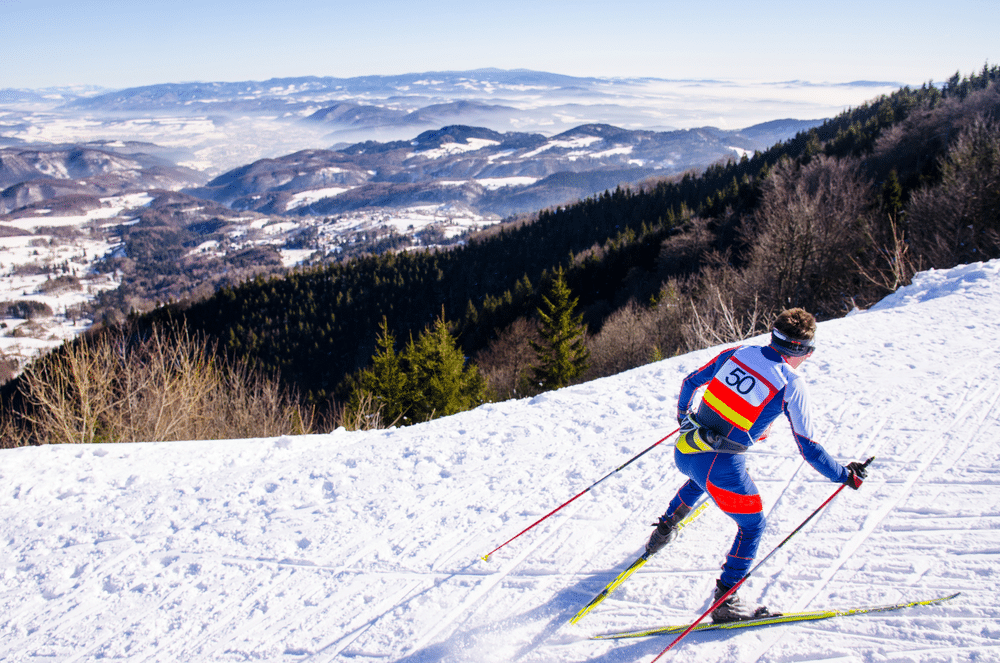
Body Position
For efficient ski skating, it is essential to maintain a proper body position. You should lean slightly forward with your hips over your feet. This position helps you balance and transfer power effectively during the side to side movement. Your arms should be loose but prepared to participate in the poling motion, and your knees should be slightly bent. Engage your core to keep your body stable and make moving easier.
Leg Push
One essential element of ski skating is the leg push. Ski skating is similar to inline skating in that it propels your legs outward in contrast to the forward motion of classic cross-country skiing. This lateral push helps propel you forward. Start by shifting your weight onto one ski and extending the other leg outside at an angle to perform an effective leg push. Your hip and thigh muscles should be the source of the push, with your feet and ankles remaining comparatively relaxed.
Gliding Ski
When you push off with one leg, your weight should transfer onto the gliding ski. Maintaining a smooth glide, reducing friction, and increasing speed are crucial. This is when the ski edges come into play; good edging keeps things under control and directed. Maintain your other leg relaxed and prepared for the next push while evenly distributing your weight over the gliding ski. Skiing becomes more efficient the longer and smoother you glide.
Double Pole
The double pole method is employed to keep rhythm and increase speed. You can increase the force in your motion by planting both poles at the same time and pushing off with your upper body. This technique is especially useful on flat terrain and slight inclines. Plant your poles slightly in front of your feet, tense your core, and push down and back on the poles with your upper body to execute a double pole.
3. Developing Your Balance and Coordination
Balance and coordination are crucial in skate skiing. To improve these abilities, try these exercises:
One-Legged Glides
To improve your balance, try gliding on one ski at a time. Keep your weight centered over the ski and your core tight.
Double Pole Pushes
Do double pole pushes without moving your legs to strengthen your upper body and enhance your pole planting technique.
Skate Without Poles
To improve your leg motion and weight transfer, practice skating without poles.
4.Building Endurance and Strength
Interval Training
Incorporate interval training into your workouts. Balance rest intervals and high-intensity bursts to increase your speed and cardiovascular endurance.
Strength Training
Focus on exercises that build leg, core, and upper body strength. Squats, lunges, planks, and push-ups are excellent choices.
Flexibility
Stretch frequently to maintain flexibility. Pay close attention to your hips, lower back, and legs to increase your range of motion and avoid injuries.
5. Advanced Techniques Of Skate on Skis
You can start implementing advanced techniques to improve your performance as you get more accustomed to the fundamentals of skate on skis.
V1 Technique
The V1 technique involves a single pole plant for every leg push. This method requires good timing and coordination to climb hills. When using the V1 technique, you place one pole on the pushing-off leg and glide the other leg. This strategy offers extra support and power and helps you keep your momentum and control on uphill stretches.
V2 Technique
The V2 technique uses a double pole plant for every leg push. This technique enables faster speeds and works well on level terrain. With each leg push in the V2 method, you simultaneously plant both poles to produce maximum propulsion. This technique requires accurate timing in addition to strong upper body and core muscles to synchronize the leg and poling movements.
V2 Alternate
The V2 alternate technique alternates between double-pole plants and single-leg pushes. This method is versatile and appropriate for a variety of surfaces. When performing the V2 alternate, you alternate between planting one pole and both poles with each leg push. This strategy strikes a balance between force and efficiency by allowing you to modify your technique according to the terrain and your energy levels.
Tips for Mastering Skate on Skis
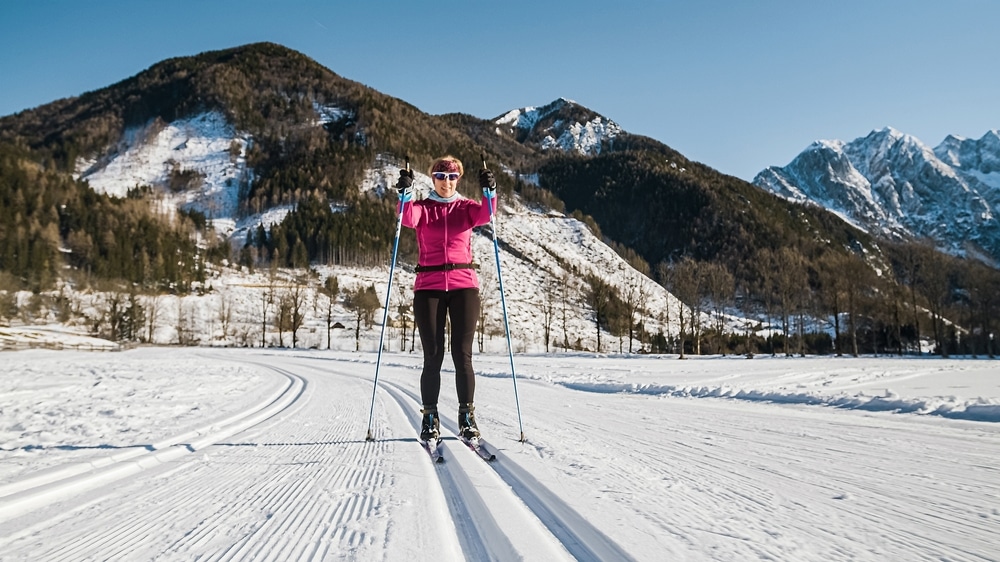
Practice Balance
Good balance is the key to efficient ski skating. Try shifting your weight back and forth while standing on one leg. Balancing exercises like yoga, utilizing a balance board, or standing on one leg can increase your stability and control on the skis.
Work on Strength
Strong legs and core muscles are essential for the powerful leg push required in ski skating. Increase your strength and stamina by including lunges, squats, and core exercises in your training regimen. Plyometric exercises, like jump squats and box jumps, can also help develop explosive power for the leg push.
Learn to Glide
Focus on long, smooth glides. The longer you can glide, the more effective your movement will be. Practice gliding on level ground and slight slopes to gain more control and balance. To maintain a steady and controlled glide, focus on your weight distribution and the edges of your skis.
Use the Right Equipment
Ensure your ski boots, poles, and skate skis are properly fitted and suited to your skill level and style. Get assistance from an experienced ski instructor or retailer to ensure you have the appropriate equipment. An appropriate fit for your gear can greatly improve both your comfort and performance on the trails.
Master the Double Pole
The double pole technique can significantly enhance your speed and efficiency. Use your upper body and core for maximum power while keeping your movements smooth and rhythmic.
Stay Relaxed
Tension can lead to inefficiency and fatigue. Maintain a comfortable posture throughout, paying particular attention to your arms and shoulders. Focus on maintaining a fluid and smooth motion, and avoid tensing up. Maintaining your equilibrium can help you use less energy and perform better all around.
Dress Appropriately
Layering is key in winter sports. Wear moisture-wicking base layers, insulating mid-layers, and a windproof outer layer. Don’t forget a hat, gloves, and sunglasses or goggles to protect your eyes.
Nutrition and Hydration
Stay hydrated and fuel your body with the right nutrients. Carry water and snacks with you, especially for longer sessions.
Different Types of Cross-Country Skiing
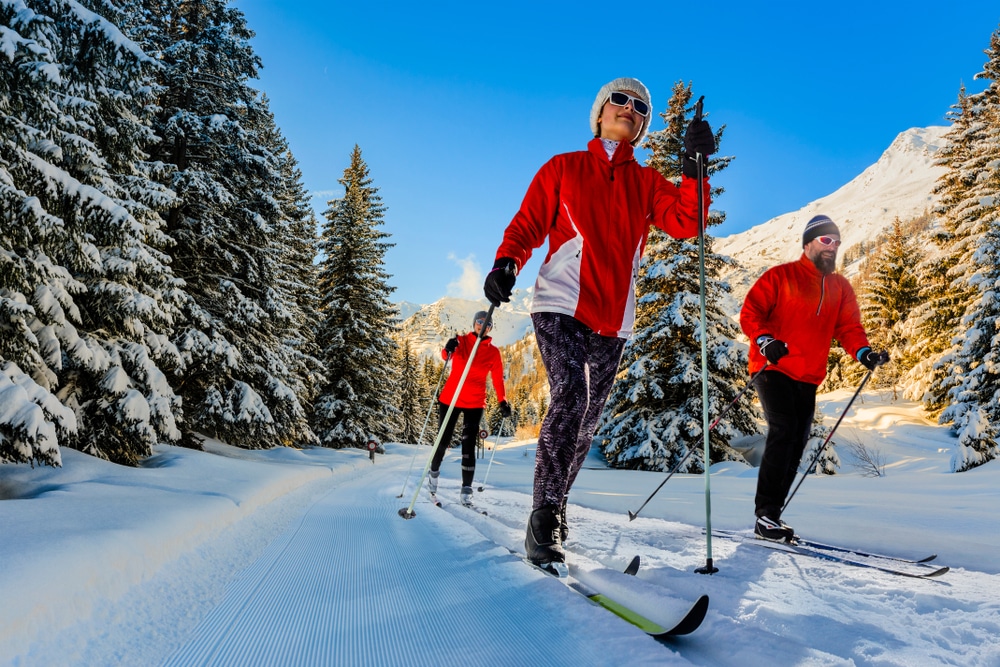
Skate skiing is just one type of cross-country skiing. There are several other styles, each with its own set of techniques and equipment.
Classic Cross Country Skiing
Classic cross-country skiing involves a straight-line motion similar to walking or running. This style, which works well on groomed tracks, mainly uses kick-and-glide and diagonal striding. In classic cross-country skiing, the skier alternates between pushing off one ski and gliding on the other as the skis travel parallel. This technique is often used in traditional cross-country ski races and recreational skiing on groomed trails.
Cross Country Skate Skiing
Cross-country skate skiing, or skate on skis, is characterized by the V-shaped stride. While this approach is usually faster than classic cross-country skiing, it does involve more physical effort. Skaters execute a series of quick, forceful leg pushes and glides with the skis in a V configuration.
Race Ski
For those interested in competition, race ski techniques and equipment are designed for speed and efficiency. Equipment for race skiing is typically more aerodynamic and lighter.
Conclusion
Skate on skis is a versatile and exciting way to enjoy the beauty of winter months. Whether you’re new to the sport or looking to improve your skills, understanding the equipment, mastering the techniques, and staying consistent with practice are key to success. Embrace the challenge, enjoy the outdoors, and experience the thrill of ski skating by combining the best of skiing and skating in one exhilarating winter sport.

